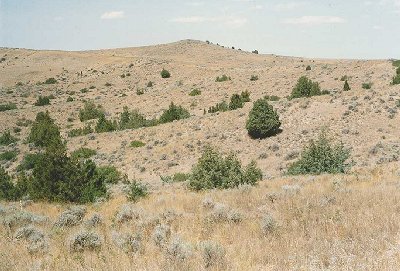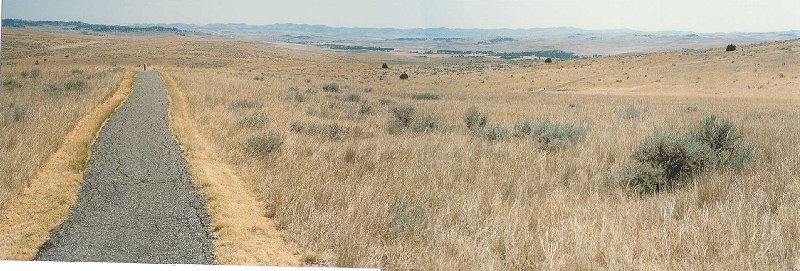
Little Big Horn Part 3

Ridge Defense Line
To recap, Custer had kept 115 men in three companies under Cpt. Frederick Benteen on the ridge while 140 men in three companies under Maj. Marcus Reno crossed the river and attacked the near end of the camp. This attack took place in the mass of trees visible in the plain below. Reno's attack was shattered, with losses of 40 killed, 13 wounded, and a number of missing. The survivors rushed back across the river following a roundabout route roughly around the outside curve of the wooded area and up the ridge through the ravine on the far right of the picture to join Benteen. The paved trail on the left marks part of the cavalrymen's perimeter during the fight.

Sharpshooter Ridge
After advancing just over a mile to find Custer, Reno fell back to his original position and established his defensive lines at about 7PM. Soon the position was surrounded by the entire Indian force. Just 500 yards to the north was Sharpshooter Ridge. Here, Indian sharpshooters, one in particular, fired down on the troopers. After killing several soldiers, a volley was directed at the Indian, and he was eliminated.

From Sharpshooter Ridge
This is the view from the ridge. You can see the valley below where the Indian camp was attacked and on the leftmost picture is the ridge held by the surviving troopers.

Eastern Side
Warriors soon put the cavalrymen under heavy fire from the eastern side of the perimeter from about 500 yards. This is the view along the line of Company G. Just before the sign at the end of the path, the troopers made a barricade of saddles, dead horses, and anything else they could find. At the sign, the line angled to the right and can be seen as it climbs the ridge to the far right of the picture. Company A defended this area. Company H extended the line further down the ridge. The bowl on the right of the picture was used as a field hospital.
During the night, Benteen got 15 volunteers to sneak down to the river along a ravine to get water for his men while four men provided covering fire. The mission succeeded and was vital to the successful defense. The battle continued into June 26th, with the men pinned down the entire day. That evening, the Indians appeared to pack up and leave. Unable to believe this was not a trick, the troopers spent another night in their position. The next morning they spotted another cloud of dust. It was Terry and Gibbon coming to their rescue.
The battle was over. Although an Indian success, news of Custer's defeat put a damper on America's centennial celebrations and increased the resolve to end Indian problems for good.